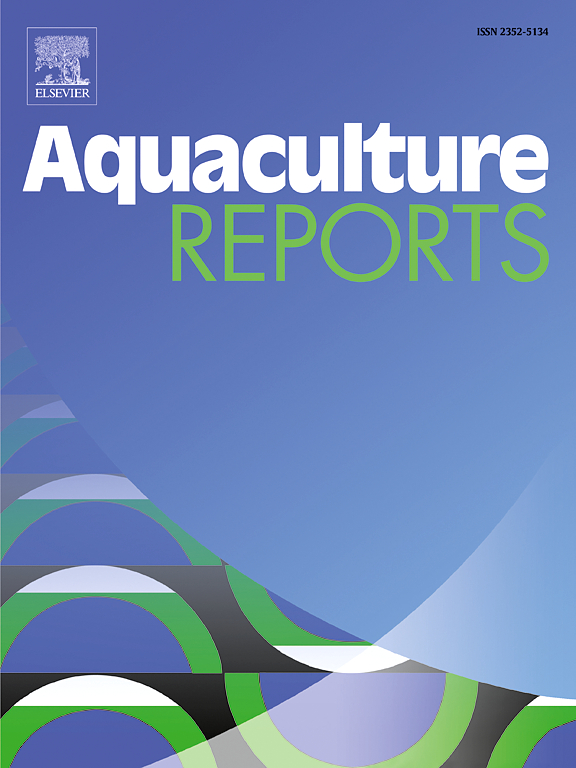Anesthesia of Baryancistrus xanthellus (Siluriformes: Loricariidae): Bioassays with exposure and re-exposure cause reverse tolerance to eugenol
IF 3.2
2区 农林科学
Q1 FISHERIES
引用次数: 0
Abstract
Baryancistrus xanthellus (Golden Nugget Pleco) is an ornamental catfish endemic to the Xingu River basin in Brazil and widely exported for the aquarium trade. This study evaluated the effectiveness of eugenol anesthesia in B. xanthellus under two scenarios: an initial exposure and a re-exposure to the same anesthetic. The experiments were conducted in two phases, two months apart, each testing incremental concentrations of eugenol (2 mg·L−1 added at two-minute intervals) until reaching surgical anesthesia. Two control groups (water only and 70 % ethanol at equivalent concentrations) were subjected to identical handling and observation procedures. Data were analyzed using Permutational Analysis of Variance (PERMANOVA), treating anesthesia stage as the dependent variable, eugenol concentration as the independent variable, and fish size plus exposure history as covariates. The results revealed reverse tolerance to eugenol: fish re-exposed to the anesthetic required significantly lower concentrations to achieve surgical anesthesia (14.50 ± 3.20 mg·L−1) than during the initial exposure (21.69 ± 3.38 mg·L−1). However, recovery times did not differ significantly between the first and second exposures. No mortality occurred within 72 hours post-anesthesia in any group, indicating low short-term toxicity. These findings highlight the need to re-evaluate anesthetic protocols for repeated procedures in ornamental catfish. We also propose new reference tables specifically tailored to describe anesthesia and recovery stages in benthic Loricariids. Further investigations into the biochemical and physiological mechanisms underlying reverse tolerance to eugenol are warranted.
黄叶大腹蟹的麻醉:暴露和再暴露引起对丁香酚的反向耐受的生物测定
Baryancistrus xanthellus (Golden Nugget Pleco)是巴西新谷河流域特有的观赏鲶鱼,广泛出口到水族贸易。本研究在两种情况下评估了丁香酚麻醉对黄芽孢杆菌的有效性:首次暴露和再次暴露于相同的麻醉剂。实验分两个阶段进行,间隔两个月,每阶段测试丁香酚的增量浓度(2 mg·L−1,每两分钟添加一次),直到达到手术麻醉。两个对照组(仅用水和同等浓度的70% %乙醇)采用相同的处理和观察程序。以麻醉阶段为因变量,丁香酚浓度为自变量,鱼体大小加暴露史为协变量,采用Permutational Analysis of Variance (PERMANOVA)对数据进行分析。结果显示了对丁香酚的反向耐受:再次暴露于麻醉剂的鱼实现手术麻醉所需的浓度(14.50 ± 3.20 mg·L−1)明显低于首次暴露时的浓度(21.69 ± 3.38 mg·L−1)。然而,恢复时间在第一次和第二次暴露之间没有显着差异。麻醉后72 小时内各组均无死亡发生,说明短期毒性低。这些发现强调了重新评估观赏鲶鱼重复麻醉程序的必要性。我们还提出了新的参考表,专门用于描述底栖Loricariids的麻醉和恢复阶段。对丁香酚反向耐受性的生化和生理机制的进一步研究是必要的。
本文章由计算机程序翻译,如有差异,请以英文原文为准。
求助全文
约1分钟内获得全文
求助全文
来源期刊

Aquaculture Reports
Agricultural and Biological Sciences-Animal Science and Zoology
CiteScore
5.90
自引率
8.10%
发文量
469
审稿时长
77 days
期刊介绍:
Aquaculture Reports will publish original research papers and reviews documenting outstanding science with a regional context and focus, answering the need for high quality information on novel species, systems and regions in emerging areas of aquaculture research and development, such as integrated multi-trophic aquaculture, urban aquaculture, ornamental, unfed aquaculture, offshore aquaculture and others. Papers having industry research as priority and encompassing product development research or current industry practice are encouraged.
 求助内容:
求助内容: 应助结果提醒方式:
应助结果提醒方式:


